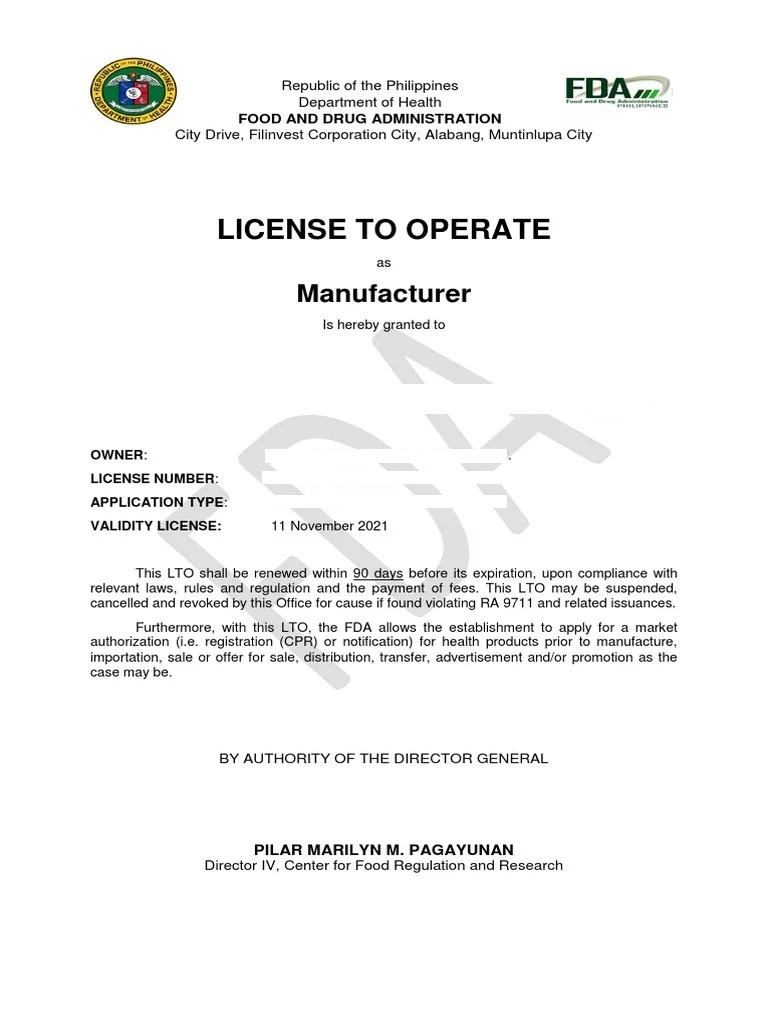The Food and Drug Administration (FDA) Act of 2009, officially known as Republic Act 9711, established the FDA as the regulatory authority in the Philippines for ensuring the safety, efficacy, and quality of food, drugs, cosmetics, medical devices, and other health products. It empowers the FDA to enforce standards, conduct inspections, issue licenses, and implement policies to protect public health.
Under the Implementing Rules and Regulations (IRR) of R.A. 9711, there are four centers overseeing four major product categories regulated under the law. These include the Center for Drug Regulation and Research (i.e., covering also veterinary medicines, vaccines, and biologicals), the Center for Food Regulation and Research, the Center for Cosmetics Regulation and Research (i.e., including household or urban hazardous substances), and the Center for Device Regulation, Radiation, Health, and Research.
FDA Product Registration, or simply FDA Registration, is the process of officially registering products with the Food and Drug Administration (FDA) in the Philippines to ensure they meet the safety, quality, and regulatory standards. It is mandated for all FDA-regulated health products prior to their manufacture, importation, exportation, marketing, sale, and distribution.
An FDA Certificate of Product Registration (CPR) is issued after an approved application for a health product and serves as a prima facie evidence of the registrant’s marketing authority for the product in connection with the activities permitted pursuant to the License to Operate (LTO). Only establishments with a valid LTO may apply for product registration.
FDA-Regulated Products
All health-related products, including food, drugs, cosmetics, devices, biologicals, vaccines, in-vitro diagnostic reagents, and hazardous substances, must comply with FDA regulations.
Food
As defined by the IRR, food is any processed substance, which is intended for human consumption and includes drinks, beverages, chewing gum, and any substances used as an ingredient in the manufacture, preparation, or treatment of food.
Food and Dietary Supplements
These are processed food products intended to supplement the diet and bear or contain one or more of the dietary ingredients such as vitamins, minerals, amino acids, herbs, and other dietary substances.
Drugs
These are articles recognized in official pharmacopoeias and formularies intended for use in the diagnosis, cure, mitigation, treatment, or prevention of diseases in humans and animals.
In-Vitro Diagnostic Reagents
These are reagents and systems intended for use in the diagnosis of disease or other conditions, including a determination of the state of health, in order to cure, mitigate, treat, or prevent disease or its sequelae.
Veterinary Drugs
These are drugs intended for use for animals, including those intended for use in animal feeds, but excluding animal feeds themselves.
Cosmetics
These are substances or preparations intended to be placed in contact with the various external parts of the human body with a view to exclusively protecting or keeping them in good condition.
Health Devices
These include medical, radiation, and health-related devices intended to be used alone or in combination for diagnosis, prevention, monitoring, or support of the anatomy or physiological processes, including life support.
Household/Urban Hazardous Substances
These are substances or mixtures that are toxic, corrosive, irritating, or flammable and can cause significant harm or illness to people through ingestion, but excluding agricultural chemicals, radioactive substances, and certain fuels or refrigerants.
Benefits of FDA Product Registration
FDA product registration offers key benefits for businesses in industries like food, pharmaceuticals, cosmetics, and medical devices. Here are the main advantages:
Legal Compliance
FDA registration guarantees that your product meets the legal requirements set by the Philippine government and is not banned or recalled due to non-compliance with safety standards. It thus helps you avoid hefty fines and penalties.
Consumer Trust and Confidence
Consumers are more likely to trust and patronize your FDA-registered products, knowing they have passed rigorous safety and quality checks. With transparency, you can build brand credibility and a loyal customer base.
Market Access
Without FDA registration, your products, whether imported or locally manufactured, cannot enter the Philippine market. Thus, registration opens up opportunities for wide product distribution, be it through retail chains or established distribution networks.
Consumer Protection
FDA registration helps protect your consumers by ensuring that your products meet safety and quality standards. It can also provide you with legal recourse if a registered product is found to be harmful or defective.
Business Growth and Expansion
FDA registration can give your business a competitive edge by differentiating your products from your unregistered competitors. It can also attract investors who see the value in a company that complies with regulatory standards.
Product Innovation and Development
With the guidelines and best practices set by the FDA, you can always guarantee that your manufactured and distributed products are safe and effective. Regulatory support can also help you streamline your process of product development.
FDA Product Registration Process in the Philippines (Step-By-Step Guide)
Obtaining an FDA Certificate of Product Registration (CPR) in the Philippines requires getting a License to Operate (LTO), submitting documents, and undergoing evaluations to ensure compliance with regulations.
1. Obtain a License to Operate (LTO) from FDA.
Before registering any FDA-regulated product, you must first obtain an FDA License to Operate (LTO). This is required for all covered manufacturers, importers, exporters, distributors, and wholesalers to legally operate in the country under the FDA regulations.
The FDA LTO application typically requires an application form, proof of business registration, a site master file (i.e., for manufacturers of drugs, devices, and cosmetics), a risk management plan, payment of fees, and others depending on the nature of products.

An FDA License to Operate (LTO) is an official authorization granted to food, medical device, and drug establishments, certifying their compliance with regulatory standards for operation.
2. Determine the Product Type and Registration Needed.
Understanding the type of product you are registering is crucial, as different products require specific requirements and certifications.
- Certificate of Product Registration (CPR). This is the most common type of registration certificate that applies to food, drugs, and household/urban hazardous products.
- Certificate of Product Nomination (CPN). This mostly applies to cosmetic products, toys, childcare articles, and others related.
- Certificate of Medical Device Registration (CMDR). This is required for medical devices and other related products.
3. Prepare Documentary Requirements.
After determining the required certification, you may already start preparing the documentary requirements and other proof to support registration. These normally include the following:
- Application Form
- Valid License to Operate (LTO)
- Product Labels (i.e., in all packaging sizes and from different angles; supporting documentation must be provided for logos, seals, and certification per labeling regulations (e.g. Halal, Sangkap Pinoy Certificate, product information. etc.)
- Product Documents (product claims, such as documents detailing physiochemical or microbiological regulations under the ASEAN direction regulations)
- Certificate of Analysis (details on the product relevant to food standards and regulations compliance)
- Product Sample (i.e., in actual commercial presentation and complete with labels)
- Other Documents (e.g., valid LTOs of distributors and importers, etc., proof of payment of fees, etc.)
4. Register on the FDA’s Online Portal (eSubmissions Portal) for Pre-Assessment.
Once all documentary requirements are available, you may already proceed to register through the FDA’s eSubmissions Portal for pre-assessment. You should also upload digital copies of the requirements as instructed.
5. Pay the Registration Fees.
Next, pay the required registration fees either at the FDA cashier or through online payment channels. Once the payment is processed, the application will proceed to the evaluation stage, where the FDA reviews the documents and samples provided.
6. Submit Samples and Lab Test Results (as required).
For certain products, especially food or medical devices, submitting samples and laboratory test results are usually mandatory to ensure compliance with regulatory standards.
7. Wait for FDA Evaluation and Inspection.
After submitting all documents and samples, the FDA will evaluate the application. This may include a facility inspection or further review of product information to ensure the product meets safety, efficacy, and quality standards as required by Philippine law.
8. Receive the FDA Certificate of Product Registration (CPR).
If the FDA finds that the product complies with all regulations, it will approve the application. It will issue an FDA Certificate of Product Registration (CPR) (or whichever is applicable) that signifies that the product is officially registered and authorized for sale and distribution in the Philippines. Simply follow the email instructions on how to download or receive the certificate.

An FDA Certificate of Product Registration (CPR) is an official document that confirms a product, such as food, drugs, or medical devices, has been approved for sale and distribution after meeting regulatory requirements.
6 Grounds for Disapproval of Application and Suspension/ Cancellation of Product Registration
Any of the following or similar instances can be grounds for the disapproval of an application and suspension or cancellation of FDA product registration:
- The application requirements submitted show that the establishment does not meet the required technical requirements or appropriate standards;
- The applicant made misrepresentations, false entries, or withheld any relevant data contrary to the provisions of the law or these Rules and Regulations or appropriate standards;
- The holder or owner has violated any of the terms and conditions of its authorization or registration;
- The label of the health product is false and misleading or does not conform with current labeling requirements;
- The holder or owner of the CPR/authorization, without legitimate reason, fails to sell the health product or fails to cause it to be marketed during an uninterrupted period of at least three (3) years from date of issuance or renewal of the registration or the last date of operation or marketing;
- Such other analogous grounds or causes as determined by the FDA.
FDA Certificate Validity
The validity of FDA licenses and certificates usually varies depending on the product classification and registration. Licenses to Operate (LTO) for food, medical device, and drug establishments are typically valid for two (2) years.
Certificates of Product Registration (CPR) for food have the longest validity, which lasts five (5) years, while others are valid for one (1) to two (2) years. Certificates of Product Nomination (CPR) for cosmetics and other related products come with one (1)-year validity.
… and you might just need our assistance.
Ready to obtain an FDA License to Operate (LTO) and Product Registration in the Philippines? Set up a consultation with FilePino today! Call us at (02) 8478-5826 (landline) and 0917 892 2337 (mobile) or send an email to info@filepino.com.









